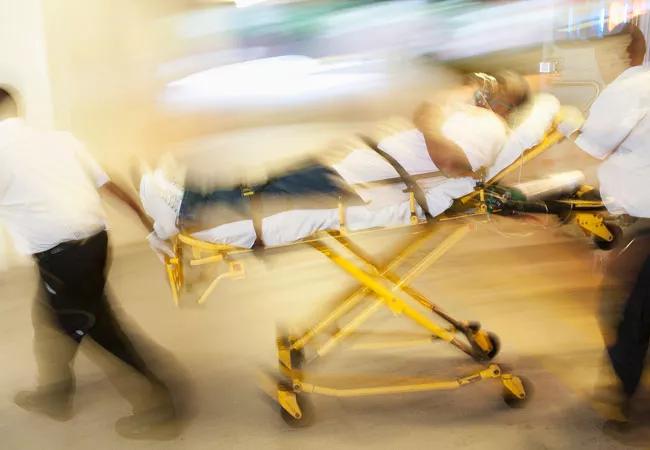Group advocates for stroke systems of care supported by telestroke and proper reimbursement

Approximately 795,000 people in the U.S. experience a new or recurrent stroke each year, and 142,000 do not survive the acute event. “It’s essential that we establish standards and organized stroke systems of care instead of at-will systems that allow too many patients to receive inadequate care,” says Andrew Russman, DO, Head of the Stroke Program and Medical Director of the Comprehensive Stroke Center at Cleveland Clinic, who recently helped update the American Academy of Neurology’s (AAN) position statement on stroke care. Dr. Russman also serves as Vice Chair of the AAN’s Stroke & Vascular Neurology Section.
Advertisement
Cleveland Clinic is a non-profit academic medical center. Advertising on our site helps support our mission. We do not endorse non-Cleveland Clinic products or services. Policy
The last AAN position paper on stroke care was issued in 2010. “I was not involved in drafting the previous version,” says Dr. Russman, who notes that version focused mainly on legislative and policy issues related to stroke care. “It was not all-encompassing, especially in regard to clinical matters. The goals of our new iteration were to provide a more comprehensive statement on stroke care from the perspective of neurologists.”
Dr. Russman was recruited to work on the AAN statement group because of his extensive interest in stroke care and his involvement in stroke legislative efforts in Ohio.
He encourages neurologists to read the short guidance so they can articulate the positions of the AAN, but he notes that these specialists are not the statement’s target audience. “This is a message from neurologists to other stakeholders in stroke care — including healthcare systems, legislators, national policymakers, licensing and regulatory boards, emergency medicine technicians and societies, prehospital care providers and technology companies — about policy measures to promote high-quality, safe and cost-effective management for people who suffer strokes.”
While the new position statement has been updated substantially, Dr. Russman identified the following areas as those of highest interest and/or with the most significant changes.
1) Stroke center designation. Three types of stroke centers have emerged over the past few years, the statement notes: primary stroke centers, thrombectomy-capable stroke centers and comprehensive stroke centers. “It’s important that each type of center be recognized for its capabilities so that patients can be transported to hospitals where they can receive the specific services they urgently require,” Dr. Russman says.
Advertisement
Primary stroke centers have the capability to care for many stroke patients, but thrombectomy-capable stroke centers, which are now being certified by various bodies and held to a higher standard of performance, can care for most patients. Comprehensive stroke centers have the ability to manage all stroke patients and are required to have neurocritical care units. “Ideally, we are calling for the development of stroke systems of care that link all three types of centers,” he says.
In addition, although current standards don’t require that neurologists serve as stroke medical directors at these centers, Dr. Russman and coauthors assert that neurologists — ideally those with training in vascular neurology — should be appointed to run hospital-based stroke programs. “We’re not saying every stroke patient needs to be cared for by a neurologist within a certain period of time and to an elevated standard such as we do at centers like Cleveland Clinic,” he explains. “But we want to establish a reasonable bar for stroke competence and make sure neurologists play a guiding role.”
All hospitals should also have a plan for managing acute stroke patients that includes rapid imaging and identification of those with large-vessel occlusion who should be transferred to a comprehensive stroke center or a thrombectomy-capable stroke center. In keeping with that, emergency personnel should know which local hospitals can provide, on a 24/7 basis, intravenous thrombolytic therapy within 4.5 hours of ischemic stroke onset and have the capacity to care for patients after thrombolysis is performed. And EMS technicians must be able to perform prehospital triage and assessment using a stroke severity scale to determine the optimal hospital for patient transportation and delivery.
Advertisement
2) Rural stroke care and telestroke services. According to the AAN, rural hospitals need to establish partnerships with larger hospitals and gain access to telestroke services, which can bring high-level expertise to the patient’s bedside and compensate for a lack of local services. “Telestroke programs standardize assessment, triage and administration of thrombolysis,” Dr. Russman says. “They also result in cost savings and reduce the number of stroke patients who are reflexively transferred to other hospitals when they don’t need to be and would prefer to stay at their local hospital.”
3) Reimbursement. The position statement calls for changes in reimbursement for both telestroke services and on-call availability for stroke emergencies. “Current compensation is not adequate and disincentivizes physicians to perform these services,” Dr. Russman observes.
Advertisement
Advertisement

Advances in genomics, spinal fluid analysis, wearable-based patient monitoring and more

Case study of radial-to-axillary nerve transfer for tumor-related deltoid nerve injury

An update on the technology from the busiest Gamma Knife center in the Americas

Real-time adjustments may help reduce bothersome dyskinesias

Anatomical modeling can identify optimal surgical candidates, study suggests

Add AI to the list of tools expected to advance care for pain patients

New guidelines from Brain Trauma Foundation urge early and aggressive treatment

Cleveland Clinic study investigated standard regimen